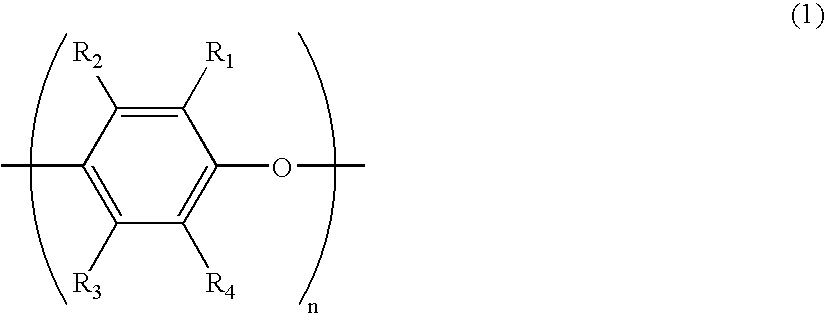Epoxy resin composition
a technology of epoxy resin and composition, which is applied in the direction of plastic/resin/waxes insulators, organic insulators, coatings, etc., can solve the problems of limited use of such a halogen solvent, environmental effects, and gelation of polyphenylene ether, and achieve excellent heat resistance, processability and adhesion properties, excellent dielectric properties
- Summary
- Abstract
- Description
- Claims
- Application Information
AI Technical Summary
Benefits of technology
Problems solved by technology
Method used
Image
Examples
preparation example 1
of Polyphenylene Ether
[0121] First, 10 parts by mass of a high-molecular weight polyphenylene ether having a number average molecular weight as large as 20,000 (manufactured by Asahi Kasei Corporation) and 30 parts by mass of bisphenol A were dissolved in 100 parts by mass of toluene with heating. To the solution mixture, 30 parts by mass of benzoyl peroxide was added and stirred at 90° C. for 60 minutes, thereby performing a redistribution reaction. Furthermore, 10 parts by mass of benzoyl peroxide was added and stirred at 90° C. for 30 minutes to complete the redistribution reaction. The reaction mixture was added to 1,000 parts by mass of methanol and the obtained precipitate was filtered off. The filtered material was further washed with 1,000 parts by mass of methanol to obtain polyphenylene ether I.
[0122] Polyphenylene ether I was analyzed by the gel permeation chromatography for molecular weight. As a result, the polyphenylene ether I had a number average molecular weight of...
preparation example 2
of Polyphenylene Ether
[0123] Polyphenylene ether II was obtained in the same manner as in Preparation Example 1 of polyphenylene ether except that the later washing step with methanol was not performed.
[0124] The polyphenylene ether II was analyzed by the gel permeation chromatography for molecular weight. As a result, the polyphenylene ether II had a number average molecular weight of 2,000 and did not contain components having a molecular weight of 20,000 or more but contained components of 300 or less. The number of phenolic hydroxyl groups per molecule was 1.7.
preparation example 3
of Polyphenylene Ether
[0125] A known method for preparing polyphenylene ether, e.g., a method disclosed in Examples of U.S. Pat. No. 6,211,327 was conducted, but the reaction was terminated in the early stage and washed with methanol. More specifically, 2,6-dimethyl phenol was reacted only for 30 minutes (although the reaction is generally conducted 100 minutes) in a solvent of toluene at a temperature ranging from 40 to 45° C. while supplying oxygen and stirring in the presence of copper bromide and di-n-butylamine as a catalyst. Subsequently, the oxygen supply was stopped. While an aqueous nitrilotriacetic acid solution was added with stirring under nitrogen sealing to extract the copper catalyst into the water phase, the temperature of the reaction mixture was raised to 55° C. and maintained at this state for 70 minutes. Thereafter, the copper catalyst was centrifugally removed, and the reaction solution was washed with a methanol solution. As a result, polyphenylene ether III ha...
PUM
| Property | Measurement | Unit |
|---|---|---|
| Fraction | aaaaa | aaaaa |
| Percent by mass | aaaaa | aaaaa |
| Percent by mass | aaaaa | aaaaa |
Abstract
Description
Claims
Application Information
 Login to View More
Login to View More - R&D
- Intellectual Property
- Life Sciences
- Materials
- Tech Scout
- Unparalleled Data Quality
- Higher Quality Content
- 60% Fewer Hallucinations
Browse by: Latest US Patents, China's latest patents, Technical Efficacy Thesaurus, Application Domain, Technology Topic, Popular Technical Reports.
© 2025 PatSnap. All rights reserved.Legal|Privacy policy|Modern Slavery Act Transparency Statement|Sitemap|About US| Contact US: help@patsnap.com



